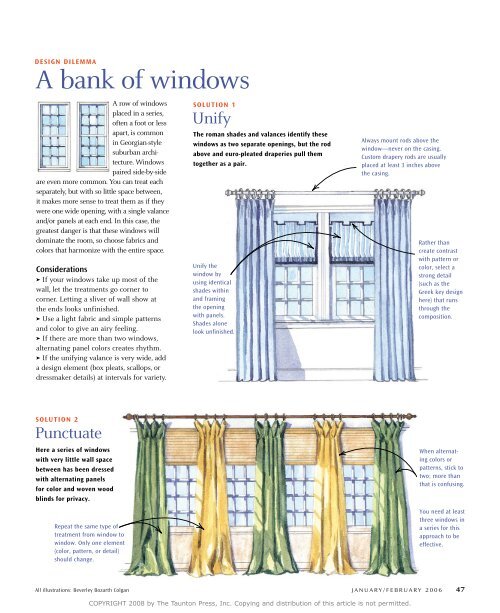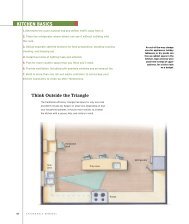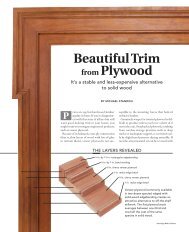Treatments for Problem Windows - Fine Homebuilding
Treatments for Problem Windows - Fine Homebuilding
Treatments for Problem Windows - Fine Homebuilding
You also want an ePaper? Increase the reach of your titles
YUMPU automatically turns print PDFs into web optimized ePapers that Google loves.
Design Dilemma<br />
A bank of windows<br />
A row of windows<br />
placed in a series,<br />
often a foot or less<br />
apart, is common<br />
in Georgian-style<br />
suburban architecture.<br />
<strong>Windows</strong><br />
paired side-by-side<br />
are even more common. You can treat each<br />
separately, but with so little space between,<br />
it makes more sense to treat them as if they<br />
were one wide opening, with a single valance<br />
and/or panels at each end. In this case, the<br />
greatest danger is that these windows will<br />
dominate the room, so choose fabrics and<br />
colors that harmonize with the entire space.<br />
Considerations<br />
➤ If your windows take up most of the<br />
wall, let the treatments go corner to<br />
corner. Letting a sliver of wall show at<br />
the ends looks unfinished.<br />
➤ Use a light fabric and simple patterns<br />
and color to give an airy feeling.<br />
➤ If there are more than two windows,<br />
alternating panel colors creates rhythm.<br />
➤ If the unifying valance is very wide, add<br />
a design element (box pleats, scallops, or<br />
dressmaker details) at intervals <strong>for</strong> variety.<br />
solution 2<br />
Punctuate<br />
Here a series of windows<br />
with very little wall space<br />
between has been dressed<br />
with alternating panels<br />
<strong>for</strong> color and woven wood<br />
blinds <strong>for</strong> privacy.<br />
Repeat the same type of<br />
treatment from window to<br />
window. Only one element<br />
(color, pattern, or detail)<br />
should change.<br />
All illustrations: Beverley Bozarth Colgan<br />
solution 1<br />
Unify<br />
the roman shades and valances identify these<br />
windows as two separate openings, but the rod<br />
above and euro-pleated draperies pull them<br />
together as a pair.<br />
Unify the<br />
window by<br />
using identical<br />
shades within<br />
and framing<br />
the opening<br />
with panels.<br />
Shades alone<br />
look unfinished.<br />
Always mount rods above the<br />
window—never on the casing.<br />
Custom drapery rods are usually<br />
placed at least 3 inches above<br />
the casing.<br />
j a n u a r y / f e b r u a r y 2 0 0 6<br />
COPYRIGHT 2008 by The Taunton Press, Inc. Copying and distribution of this article is not permitted.<br />
Rather than<br />
create contrast<br />
with pattern or<br />
color, select a<br />
strong detail<br />
(such as the<br />
Greek key design<br />
here) that runs<br />
through the<br />
composition.<br />
When alternating<br />
colors or<br />
patterns, stick to<br />
two; more than<br />
that is confusing.<br />
You need at least<br />
three windows in<br />
a series <strong>for</strong> this<br />
approach to be<br />
effective.<br />
47

















